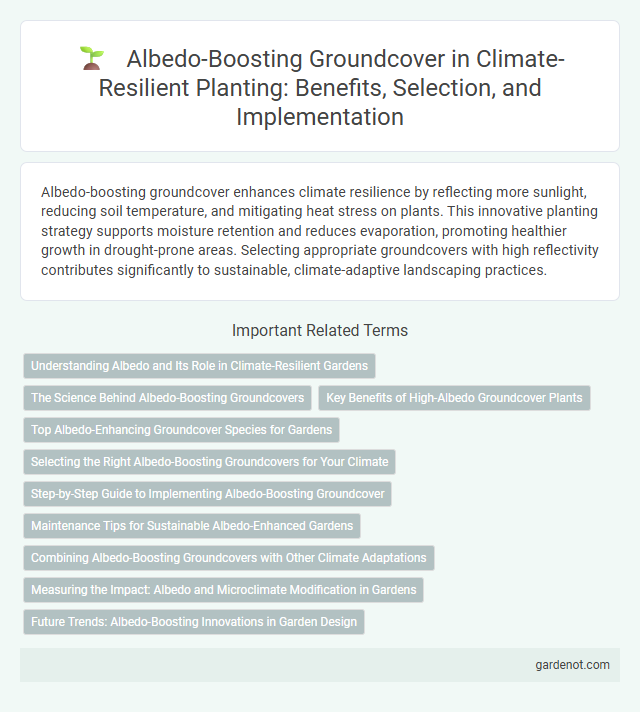Albedo-boosting groundcover enhances climate resilience by reflecting more sunlight, reducing soil temperature, and mitigating heat stress on plants. This innovative planting strategy supports moisture retention and reduces evaporation, promoting healthier growth in drought-prone areas. Selecting appropriate groundcovers with high reflectivity contributes significantly to sustainable, climate-adaptive landscaping practices.
Understanding Albedo and Its Role in Climate-Resilient Gardens
Albedo refers to the reflectivity of a surface, with higher albedo materials reflecting more sunlight and reducing heat absorption in climate-resilient gardens. Albedo-boosting groundcovers, such as white clover or silverleaf plants, help lower soil temperatures and mitigate urban heat island effects by increasing surface reflectivity. Incorporating high-albedo vegetation enhances garden cooling, conserves moisture, and supports sustainable planting strategies under changing climate conditions.
The Science Behind Albedo-Boosting Groundcovers
Albedo-boosting groundcovers increase surface reflectivity by reflecting a larger proportion of solar radiation, thus reducing heat absorption in urban and agricultural landscapes. These plants typically have light-colored leaves or a dense, reflective canopy that enhances the albedo effect, mitigating local temperature spikes and contributing to climate resilience. Researchers measure the albedo effect through spectral reflectance data, linking it to lowered soil temperatures and improved microclimate stability essential for sustainable planting strategies.
Key Benefits of High-Albedo Groundcover Plants
High-albedo groundcover plants reflect a significant portion of solar radiation, reducing soil temperatures and mitigating heat stress in urban and agricultural environments. These plants enhance climate resilience by lowering surface heat absorption, which helps decrease the urban heat island effect and preserves soil moisture. Their reflective properties promote energy efficiency while supporting plant health and reducing irrigation needs.
Top Albedo-Enhancing Groundcover Species for Gardens
Albedo-boosting groundcover species such as white clover (Trifolium repens), creeping thyme (Thymus serpyllum), and snow-in-summer (Cerastium tomentosum) effectively reflect sunlight, reducing heat absorption in garden spaces. These plants increase surface reflectivity, mitigating urban heat islands and enhancing climate resilience in landscape design. Incorporating high-albedo groundcovers optimizes energy efficiency and supports sustainable microclimate regulation in residential and commercial gardens.
Selecting the Right Albedo-Boosting Groundcovers for Your Climate
Selecting the right albedo-boosting groundcovers involves matching plant species with high reflectance properties to your specific climate's temperature and solar radiation levels. Opt for drought-tolerant varieties in arid regions to enhance soil moisture retention and reduce heat absorption, while in cooler climates, species with seasonal reflectance can maximize energy savings. Prioritize groundcovers like white clover, creeping thyme, or sedum that not only increase surface albedo but also support local biodiversity and soil health.
Step-by-Step Guide to Implementing Albedo-Boosting Groundcover
Implement albedo-boosting groundcover by first selecting light-colored, reflective plant species such as white clover or silver-leafed succulents to increase surface reflectivity and reduce heat absorption. Prepare the soil by removing debris and ensuring proper drainage to support healthy root growth and maximize albedo effectiveness. Establish planting patterns that maximize coverage and durability, regularly maintaining the groundcover to sustain its climate-resilient properties and enhance urban cooling.
Maintenance Tips for Sustainable Albedo-Enhanced Gardens
Albedo-boosting groundcover plants like white clover and lamb's ear reflect sunlight, reducing heat absorption and promoting a cooler microclimate. To maintain sustainable albedo-enhanced gardens, regularly prune dense foliage to preserve reflectivity and prevent shading that lowers albedo effect. Implementing organic mulch and seasonal soil aeration enhances soil health, supporting vigorous groundcover growth and sustained albedo benefits.
Combining Albedo-Boosting Groundcovers with Other Climate Adaptations
Combining albedo-boosting groundcovers with drought-tolerant shrub species enhances soil moisture retention while reflecting more solar radiation, reducing heat stress in urban landscapes. Integrating these reflective plants with permeable pavements and rainwater harvesting systems maximizes water efficiency and mitigates urban heat island effects. Strategic layering of high-albedo groundcovers beneath shade trees further stabilizes microclimates, promoting greater resilience against temperature extremes and improving overall ecosystem health.
Measuring the Impact: Albedo and Microclimate Modification in Gardens
Albedo-boosting groundcover significantly increases surface reflectivity, reducing heat absorption in garden spaces and lowering ambient temperatures by up to 3degC. Measuring albedo involves using spectroradiometers to quantify reflected solar radiation, helping assess the cooling effects on microclimate modification. These evaluations demonstrate that higher albedo groundcovers contribute to climate resilience by mitigating urban heat island effects and improving plant stress tolerance.
Future Trends: Albedo-Boosting Innovations in Garden Design
Emerging trends in climate-resilient planting highlight albedo-boosting groundcovers as a critical innovation to mitigate urban heat islands and enhance energy efficiency. Advanced materials and plant varieties with high solar reflectance are being integrated into garden designs to maximize cooling effects and improve microclimates. These innovations contribute to sustainable landscaping by reducing ambient temperatures and supporting carbon sequestration efforts.
Albedo-boosting groundcover Infographic

 gardenot.com
gardenot.com